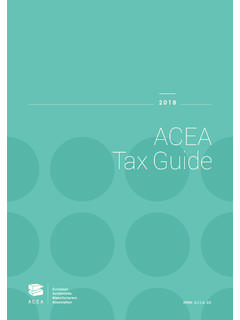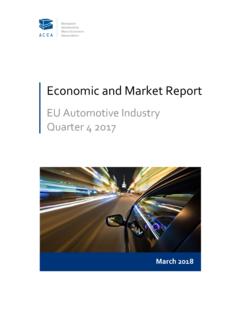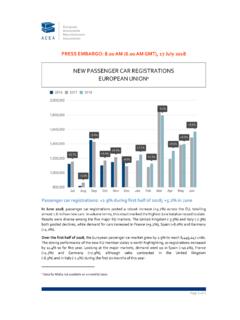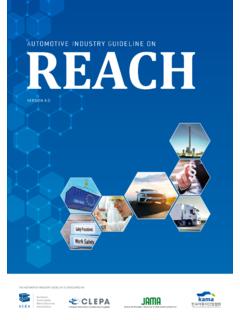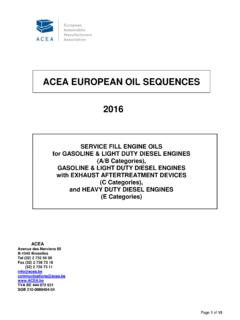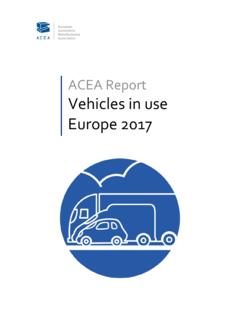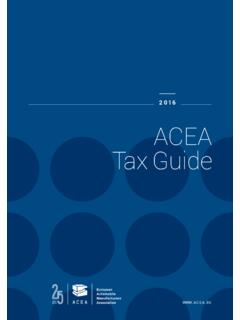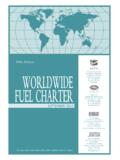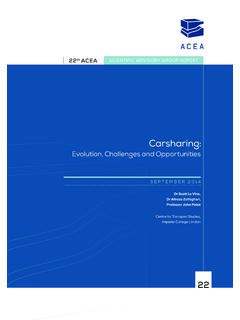Transcription of 2017 2018 - acea.be
1 2017 . 2018 . WWW. A C E A . B E. T H E A U T O M O B I L E I N D U S T RY. P O C K E T G U I D E 2 0 1 7 / 2 0 1 8 3 Foreword Each year, ACEA compiles the automobile Industry Pocket Guide in order to provide a clear and complete overview of one of Europe's most important industries. By now, it has become the point of reference for all those interested in automotive issues and policies something we are proud of! This 2017 - 2018 edition contains the latest figures on employment and trade, innovation, the environmental performance of our sector, as well as vehicle production, registration, use and taxation. More than million Europeans work directly or indirectly in the automotive sector now, representing of total EU employment. In 2016, EU passenger car production increased by , totalling million units and thus almost reaching pre-crisis levels.
2 Not only does our industry make a significant contribution to powering economic growth and creating jobs, it also spurs innovation and provides mobility for millions of Europeans. However, uncertainty is expected to overshadow our sector in the years to come. Much will depend on political developments and the evolution of macro-economic conditions. We therefore urge the EU to continue its efforts to safeguard the competitiveness of our continent, and ensure fair access to the global market place. At the same time, our industry remains committed to addressing tomorrow's challenges, which is reflected in manufacturers' ongoing efforts to reduce their environmental footprint. Even though car production has been on the rise again since 2013, manufacturers have been able to decouple CO2 emissions, energy consumption, water usage and waste generation from production growth.
3 Total CO2 emissions from car production, for example, have remained stable despite a substantial increase in production volume . while CO2 emissions per car produced dropped by between 2007 and 2016. The same level of ambition applies to our objective of making mobility cleaner, smarter and safer in the future. To that end, the automotive sector invests billion in innovation each year. This not only makes us the EU's largest investor in R&D, but also marks our highest annual investment in innovation on record. Erik Jonnaert ACEA Secretary General WWW. A C E A . B E. ABOUT ACEA. 5. ACEA represents Europe's car, van, truck and bus makers Members and partners The european automobile Manufacturers' Association (ACEA) is the advocate for the automobile industry in Europe, representing manufacturers of passenger cars, vans, trucks and buses with production sites in the EU.
4 ACEA's members are: BMW Group, Daimler, DAF Trucks, Fiat Chrysler Automobiles, Ford of Europe, Hyundai Motor Europe, Iveco, Jaguar Land Rover, Opel Group, PSA Group, Renault Group, Toyota Motor Europe, Volkswagen Group, Volvo Cars, and Volvo Group. ACEA has permanent cooperation with the european Council for Automotive R&D (EUCAR), which is the industry body for collaborative research and development. ACEA works closely with the 29 national automobile manufacturers' associations in Europe, and maintains a dialogue on international issues with automobile associations around the world. WWW. A C E A . B E. T H E A U T O M O B I L E I N D U S T RY P O C K E T G U I D E 2 0 1 7 / 2 0 1 8 6. ACEA's mission and priority areas ACEA's mission Define and advocate the common interests, policies and positions of the european automobile industry.
5 Engage in dialogue with the european institutions and other stakeholders in order to advance understanding of industry issues, and to contribute to effective policy and legislation at both european and global levels. Act as a portal for expert knowledge on vehicle-related regulation. Communicate the role and importance of the industry, using reliable data and information. Monitor activities that affect the automobile industry, cooperating with the other stakeholders involved. Undertake strategic reflection on the increasingly global challenges of mobility, sustainability and competitiveness. Priority fields Through its member companies, ACEA taps into a wealth of technical, regulatory and practical expertise in the following priority fields: Connected and Automated Driving Competitiveness, Market and Economy Environment and Sustainability International Trade Research and Innovation Safety Transport Policy WWW.
6 A C E A . B E. ABOUT ACEA. 7. How ACEA works The ACEA Board of Directors is composed of the CEOs and Presidents of its member companies. Additionally, a Commercial Vehicle Board of Directors addresses the specific issues that face the commercial vehicle manufacturers that ACEA. represents: DAF Trucks, Daimler Trucks, Iveco, MAN Truck & Bus, Scania, Volkswagen Commercial Vehicles and Volvo Group. The day-to-day work of the ACEA secretariat is overseen by the Secretary General, who ensures that the Board of Directors' priorities are addressed. Technical expertise and advisory input comes from working groups on topics as diverse as emissions, road and vehicle safety, general transport policy, and regulatory compliance. These specialist working groups are made up of experts from the member companies.
7 WWW. A C E A . B E. T H E A U T O M O B I L E I N D U S T RY P O C K E T G U I D E 2 0 1 7 / 2 0 1 8 8. The european Council for Automotive R&D (EUCAR). is the collaborative research organisation of the major automobile manufacturers in Europe, with the mission to strengthen the competitiveness of the manufacturers through strategic collaborative research and innovation. Together with its members, EUCAR drives the strategy and assessment of collaborative automotive research and innovation, and establishes common work with the european Commission, member states and other key stakeholders. These activities facilitate the participation of EUCAR's members in high-quality projects with industrially-relevant results. Projects are mainly financed through the european Union Framework Programmes for research and innovation, matched with industry funding.
8 EUCAR collaborative research and innovation activities cover both passenger and commercial vehicles, focused on the following strategic pillars: SAFE & INTEGRATED SUSTAINABLE AFFORDABILITY. MOBILITY PROPULSION & COMPETITIVENESS. Smart and safe vehicles Collaborative automotive New sustainable approach for all purposes, integrated R&I towards propulsion to developing and producing into a secure and intelligent systems which are clean affordable and competitive transport system, and energy efficient over vehicles in Europe progressing towards the full life-cycle, with seamless mobility cost-effective technologies, for all, maximum efficiency while maintaining customer and ever-fewer accidents priorities COMMERCIAL VEHICLES. An integrated approach for reliable, clean, safe and efficient freight transport and passenger mobility, through dedicated vehicle concepts and effective logistics WWW.
9 A C E A . B E. ABOUT ACEA. 9. EUCAR is governed by its Council, composed of the heads of the research and advanced development divisions of the member companies. The EUCAR Chairman is nominated annually from the Council on a rotating basis. EUCAR's members are: BMW Group, DAF Trucks, Daimler, Fiat Chrysler Automobiles, Ford of Europe, Hyundai Motor Europe, Iveco, Jaguar Land Rover, Opel Group, PSA Group, Renault Group, Toyota Motor Europe, Volkswagen Group, Volvo Cars, and Volvo Group. WWW. A C E A . B E. T H E A U T O M O B I L E I N D U S T RY P O C K E T G U I D E 2 0 1 7 / 2 0 1 8 10. Key figures EMPLOYMENT. Manufacture of motor vehicles (EU28) million people = of EU employment in manufacturing 2015. Total (EU28 manufacturing, million people = of total EU employment 2015. services and construction).
10 PRODUCTION. Motor vehicles (world) million units 2016. Motor vehicles (EU28) million units = 20% of global motor vehicle production 2016. Passenger cars (world) million units 2016. Passenger cars (EU28) million units = 21% of global passenger car production 2016. REGISTRATIONS. Motor vehicles (world) million units 2016. Motor vehicles (EU27) million units = 18% of global motor vehicle registrations/sales 2016. Passenger cars (world) million units 2016. Passenger cars (EU27) million units = 19% of global passenger car registrations/sales 2016. Diesel (EU15) 2016. Electric (EU15) 2016. VEHICLES IN USE. Motor vehicles (EU28) million units 2015. Passenger cars (EU28) million units 2015. Motorisation rate (EU28) 573 units per 1,000 inhabitants 2015. Average age (EU25) years 2015. TRADE.
